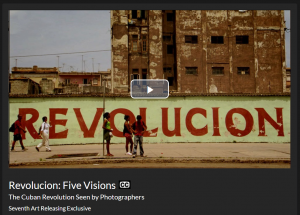Revolutions change everything about a people. Cultures shift, governments change, the actual infrastructure may be compromised, but in addition to all of the tangible changes, revolutions have massive effects on the arts. Music, film, literature, visual arts, performing arts, poetry…everything can be effected.
In this Theme Thursday, we continue to highlight Hispanic heritage, but we choose to focus not on the politics of a revolution, but how artistic communities experience and reflect on revolution. The American side of the story of our history with Cuba is pretty well known, but we’ve learned so much in time since political relations were restored. Combining this new access with scholars and artists who were permitted to visit prior to the lifted embargo, we can see how rich the arts were in Cuba under Castro.
 This documentary, available through Kanopy, reframes the Cuban revolution through the art of photography, focusing on the personal stories of five Cuban photographers whose lives and work span nearly five decades of revolution in Cuba. From Havana to Miami, photographers on both sides of the political divide reveal the Cuban people’s resilient struggle for self-determination. Whether it is the passionate resistance of the revolutionary, or the individual artist’s struggle to emerge as an independent voice in a collective society, the photographers in REVOLUCION reveal the defiance of revolutionaries and artists alike, and discover the power of art to liberate.
This documentary, available through Kanopy, reframes the Cuban revolution through the art of photography, focusing on the personal stories of five Cuban photographers whose lives and work span nearly five decades of revolution in Cuba. From Havana to Miami, photographers on both sides of the political divide reveal the Cuban people’s resilient struggle for self-determination. Whether it is the passionate resistance of the revolutionary, or the individual artist’s struggle to emerge as an independent voice in a collective society, the photographers in REVOLUCION reveal the defiance of revolutionaries and artists alike, and discover the power of art to liberate.
This book, which can be checked out from Ames, discusses the works of a prominent Cuban film artist. The films of Tomas Gutierrez Alea (1928-1996) have always defined the limits of expression in revolutionary Cuba. This book is a thorough introduction to Cuba’s most prominent filmmaker. It covers all of Alea’s twelve feature films, with special emphasis on Memories of Underdevelopment (1968), The Last Supper (1976), and Strawberry and Chocolate (1993). Not only are these considered his best films, but each is also symptomatic of an identifiable period in revolutionary Cuba – the period of triumph and affirmation in the 1960s, the period of consolidation and institutionalization in the 1970s, and the period of crisis since the fall of the Berlin Wall.
Cubans remained intent on reinforcing a Cuban identity rooted in its own culture, as exemplified by the work of Grupo Antillano. The simultaneous assimilation or synthesis of the tenets of modern western art and the development of Afro-Cuban art schools and movements created a new Cuban culture. This book, also available through Ames, offers the first comprehensive study of Grupo Antillano which thrived between 1978 and 1983 and has been written out of Cuban cultural and art history.
Check out the above resources and many more to learn more about Cuban art before, during, and after the revolution.
